







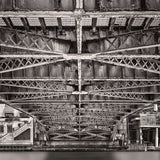
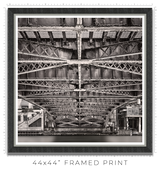
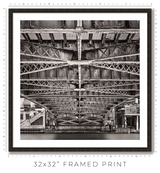
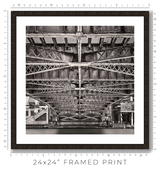
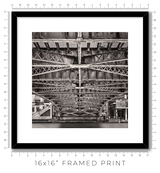
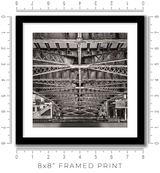
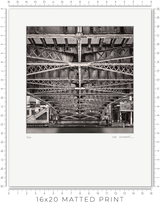
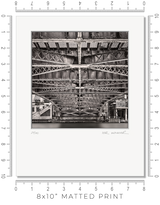
Dearborn Street Bridge
What is the connection between Dearborn Street Bridge in Chicago and the Whistler's Mother, the famous paintings, the American Mona Lisa?
Let me tell you a story.
At 5:30 am on July 14, 1803 a young man dressed in white and blue uniform, black boots and cocked hat started on a journey. He was 21 years old, his name was James Strode Swearingen and he was the 2nd Lieutenant of the US Army.
65 soldiers of the 1st Infantry company were standing in formation on a dusty field inside Fort Wayne in Detroit. They had their eyes on the Lieutenant, waiting for his order. “Turn left, march!”, he shouted at the top of his lungs.
And so they marched. The warm light from the sun rising over the morning fog showed them the way. They were heading west to the remote frontier of the Northwest Territory. No, not the Pacific Northwest, it has not been yet discovered. The Northwest Territory was the area of land of what now is Illinois, Indiana, Ohio, Michigan and Wisconsin. That was a frontier.
The destination was a place called “Chikago”, a marshy lowland at the bend of a sluggish stream entering Lake Michigan. What was so special about that place? Why was the United States government considered it strategically important? It was the shortest portage between the Great Lakes and Mississippi River. Literally it was a link between the east and the west.
The expedition had a mission to build a fort in that place. The man in charge was Captain John Whistler. But he wasn’t marching with the soldiers. Captain Whistler who was 47 at that time embarked on the schooner Tracy together with his wife and children and they sailed from Detroit around Lake Huron and Lake Michigan.
Captain John Whistler was a career soldier. As a boy he ran away from home in Ireland and enlisted in the British army. He was sent to the American colonies and fought against the rebellious insurgents during the American Revolutionary War. After the war he came back home to England, fell in love and eloped with his wife Anna. Ironically they set sails back to America. There he enlisted in the United States Army, the army he fought against just a few years later. And then destiny brought him to the remote place on the shores of Lake Michigan where he founded the city we now call Chicago.
It all happened at 2 pm on August 17, 1803 when the troops reached the Chicago River. Captain John Whistler planted the American flag into the sand and named the place Fort Dearborn in honor of Henry Dearborn who was the US Secretary of War at that time, serving under President Thomas Jefferson.
Fort Dearborn is how Chicago came to life. At first it was just a bunch of canvas tents, then log houses. The fort was burnt to the ground, re-built and destroyed again. Despite all these calamities thirty years later on August 12, 1833, the Town of Chicago was incorporated with a population of 350.
Just one year later, in August 1834 the first drawbridge was built across the Chicago River, the Dearborn Street Bridge. It was a rude construction made out of lumber. It looked like a bridge from medieval times. It didn’t last long before it broke down. Four other bridges were built in time on the same place, each time more and more advanced.
The current Dearborn Street Bridge, a typical Chicago style bascule bridge, was open to traffic in 1963. The American Institute of Steel Construction honored the bridge with the 1963 "Most Beautiful Steel Bridge" award. Thousands and thousands of people cross it every day and hardly anybody wonders why the street and the bridge have a name of Dearborn or knows the history of the place.
When I look at the Chicago architecture I see not just buildings or bridges. I see people who built them. People whose actions changed the course of history. I see legacy.
Wait. What about Whistler's Mother, the famous painting? How does it connect to this story?
That’s what I like about history. The unexpected turns and twists you may encounter on the way.
Here it goes.
John and Anna Whistler had fifteen children. It was a big family and that was the reason Captain John Whistler sailed on a schooner from Detroit to Fort Dearborn and didn’t march with the troops. It wasn’t just a military expedition for him, it was a family relocation.
One of his younger sons was George Washington Whistler. He was just a three years old toddler when he arrived with his mom and dad to the shores of Lake Michigan.
Young George spent his youth in the frontier wilderness far away from civilization. Coming from a military family he sent to the West Point when he became a teenager. He graduated and served as a topography engineer in the Army. He returned back to the west frontier surveying the land around Lake Superior.
But that’s not how he became famous. He brought America steam locomotives and railroads. That is what he was famous for.
In 1828 George Whistler together with friend and brother-in-law William Gibbs McNeill went to Great Britain and they were blown away by the power of steam engines on railroad tracks. They learnt everything they could about them and brought their knowledge back home.
George Whistler spent most of his life designing new and advanced steam locomotives and building railroads. He became so famous that Tsar Nicholas I invited George Whistler to help build the Saint Petersburg - Moscow Railway, the Russia's first major railroad. For his achievements in Russia he was even awarded the Order of Saint Anna by the Russian Emperor.
Now it’s time to talk about Whistler's Mother, the famous painting.
The actual title of the painting is Arrangement in Grey and Black No.1. It is a painting of a lady of the Victorian period sitting on a chair in front of a grey wall and looking away from the viewer.
It is on display in the Musée d'Orsay in Paris. It is considered as one of the most famous paintings by an American artist outside the United States. Some even called the American Mona Lisa.
The lady in the painting is Anna McNeill Whistler, wife of George Washington Whistler. And the artist who created the painting is their son James Abbott McNeill Whistler.
He is a grandson of Captain John Whistler, the man who built Fort Dearborn which later became the city of Chicago.
Think about this serendipitous coincidence every time you walk over the Chicago River on Dearborn Street Bridge. Human history works in mysterious ways.
P.S. If you want a comprehensive analysis of the painting, Mr Bean can offer some thoughtful insights: https://youtu.be/NNzMjrJQKsc
